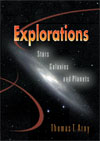 |
1 |  | 
The Sun is composed of about ______ and _______ plus 2% other elements. |
|  | A) | 71% helium / 27% hydrogen |
|  | B) | 50% hydrogen / 50% helium |
|  | C) | 71% hydrogen / 27% helium |
|  | D) | 77% nitrogen / 22% oxygen |
 |
 |
2 |  | 
The Sun is about how far from Earth? |
|  | A) | 380,000 km |
|  | B) | 93,000,000 km. |
|  | C) | 150,000,000 km. |
|  | D) | One light year. |
 |
 |
3 |  | 
What holds the Sun together? |
|  | A) | Electrostatic forces between ions in its interior. |
|  | B) | Gas pressure. |
|  | C) | Its enormous gravitational force. |
|  | D) | Nothing: the Sun is actually expanding very slowly. |
 |
 |
4 |  | 
The surface of the Sun is about ______ and the core is about _______. |
|  | A) | 6000K / 15 million K |
|  | B) | 11000K / 27 million K. |
|  | C) | Depleted / to explode |
|  | D) | all of the above |
 |
 |
5 |  | 
The Sun produces its energy through |
|  | A) | the fusion of neutrinos into helium. |
|  | B) | the fusion of positrons into hydrogen. |
|  | C) | the fusion of hydrogen into helium. |
|  | D) | electric currents generated in its core. |
 |
 |
6 |  | 
What is the specific 3-step energy process in the Sun called? |
|  | A) | Hydrostatic equilibrium |
|  | B) | Thermography. |
|  | C) | The proton-proton chain. |
|  | D) | Radiative transfer. |
 |
 |
7 |  | 
Energy production in the Sun is the equivalent of ____________. |
|  | A) | a 100 megaton H-bomb per hour |
|  | B) | a 100 megaton H-bomb per second |
|  | C) | 100 million-megaton H-bombs per hour |
|  | D) | 100 billion-megaton H-bombs per second! |
 |
 |
8 |  | 
What is the visible surface of the Sun called? |
|  | A) | The corona |
|  | B) | The chromosphere |
|  | C) | The photosphere |
|  | D) | The radiative zone |
 |
 |
9 |  | 
What is the Sun's outermost atmosphere called? |
|  | A) | The corona |
|  | B) | The chromosphere |
|  | C) | The photosphere |
|  | D) | The radiative zone |
 |
 |
10 |  | 
Why do sunspots appear dark? |
|  | A) | They are made of different material than the surrounding gas. |
|  | B) | They are hotter than the surrounding gas. |
|  | C) | They are cooler than the surrounding gas. |
|  | D) | Their magnetic fields block light. |
 |
 |
11 |  | 
How do a prominence and a flare differ? |
|  | A) | A prominence is a huge plume of glowing gas trapped in the Sun's magnetic field; a flare is a brief, bright eruption in the chromosphere. |
|  | B) | A prominence is brief, bright eruption in the chromosphere; a flare is a tenuous flow of hydrogen and helium that sweeps across the Solar System. |
|  | C) | A prominence is a jet of hot gas thousands of kilometers long; a flare is an immense bubble of hot gas rising from deep within the Sun. |
|  | D) | There is no difference. |
 |
 |
12 |  | 
What is the solar neutrino discrepancy? |
|  | A) | Astronomers detect 3 times the solar neutrinos predicted, indicating that the Sun will soon burn out. |
|  | B) | Astronomers only detect 1/3 the solar neutrinos predicted, indicating that neutrinos not fully understood. |
|  | C) | Astronomers detect 10 times the solar neutrinos predicted, indicating that fusion is poorly understood. |
|  | D) | There is no discrepancy! Astronomers detect exactly the number solar neutrinos predicted. |
 |
 |
13 |  | 
What is solar seismology? |
|  | A) | The study of the Sun's atmosphere by analyzing waves in the Sun's interior. |
|  | B) | The study of the Sun's interior by analyzing waves in the Sun's atmosphere. |
|  | C) | The study of gravitational waves from the Sun. |
|  | D) | The study of the Sun's changing size. |
 |
 |
14 |  | 
About how long is the solar cycle (evidenced by sunspots)? |
|  | A) | 3 |
|  | B) | 5 |
|  | C) | 11 |
|  | D) | 33 |
 |
 |
15 |  | 
Which of the following is evidence that solar activity affects Earth's climate? |
|  | A) | The Maunder minimum, 70 years of few sunspots, coincided with abnormally cold Northern winters |
|  | B) | Three cold periods have occurred during times of low solar activity. |
|  | C) | When the number of sunspots in a solar cycle is high, the ocean is warmer than usual. |
|  | D) | All of the above. |
 |



 2002 McGraw-Hill Higher Education
2002 McGraw-Hill Higher Education